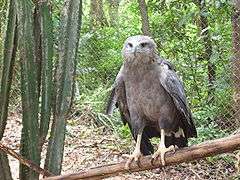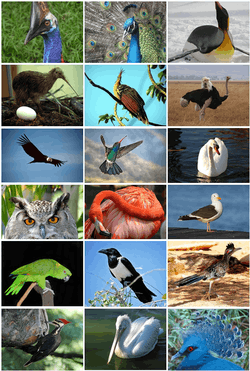Definify.com
Definition 2025
鳥
鳥
Translingual
| Stroke order | |||
|---|---|---|---|

| |||
Han character
鳥 (radical 196 鳥+0, 11 strokes, cangjie input 竹日卜火 (HAYF), four-corner 27327)
- Kangxi radical #196, ⿃ (“bird”).
Synonyms
- (bird): 隹
Derived characters
References
- KangXi: page 1480, character 52
- Dai Kanwa Jiten: character 46634
- Dae Jaweon: page 2012, character 25
- Hanyu Da Zidian: volume 7, page 4613, character 1
- Unihan data for U+9CE5
Chinese
| trad. | 鳥 | |
|---|---|---|
| simp. | 鸟 | |

Glyph origin
| Historical forms of the character 鳥
| |
|---|---|
| Oracle bone script | Small seal script |
 |
 |
| Characters in the same phonetic series (鳥) (Zhengzhang, 2003) | |
|---|---|
| Old Chinese | |
| 島 | *tuːwʔ |
| 搗 | *taːwʔ |
| 鵃 | *rtɯːw, *rtɯːw, *tjiw |
| 瞗 | *tɯːw |
| 鳥 | *tɯːwʔ |
| 蔦 | *tɯːwʔ, *tɯːws |
| 窵 | *tɯːws |
Pictogram (象形) : a bird with a dangling tail.
Compare 烏, which is very similar, of similar origin, and 隹, which originated from a similar image of a bird, but is today rather more abstract and less recognizable.
Compare also 馬 (“horse”), whose current form is similar (graphically, 灬 for claws/legs).
Etymology
Originally pronounced with a /t-/ initial (compare 島 (OC *tuːwʔ, “island”)). In many dialects, it changed to a /n-/ initial to avoid homophony with the vulgar word 屌 (diǎo, “****”), which may have developed from the sense “bird” eventually. Birds/fowl are characteristically associated with Chinese slangs for genitalia; compare 雀 (“sparrow > ****”) and 雞 (“chicken > ****”).
Alternatively, Schuessler (2007) hypothesised that the /n-/ initial form for “bird” may be unrelated to the /t-/ form. Instead, it may be connected with the Tai-Kadai word for bird; confer Proto-Tai *C̬.nokᴰ (“bird”), whence Thai นก (nók).
The /t-/ form may be derived from Proto-Sino-Tibetan *daw (“bird”), cognate with Proto-Karen *thoᴮ (“bird”) and Proto-Bodo-Garo *daw/dow (“bird”).
Pronunciation 1
- Mandarin
- Cantonese (Jyutping): niu5
- Hakka (Sixian, PFS): tiâu / niâu
- Min Dong (BUC): cēu / nēu
- Min Nan (POJ): chiáu / niáu
- Wu (Wiktionary): tiau (T2); 'nyau (T2)
- Mandarin
- (Standard Chinese, Beijing)+
- Pinyin:
- Zhuyin: ㄋㄧㄠˇ
- Wade-Giles: niao3
- Gwoyeu Romatzyh: neau
- IPA (key): /ni̯ɑʊ̯²¹⁴/
- (Standard Chinese, Beijing, erhua-ed) (鳥兒/鸟儿)+
- Pinyin:
- Zhuyin: ㄋㄧㄠˇㄦ
- Wade-Giles: niaorh3
- Gwoyeu Romatzyh: neaul
- IPA (key): /njaʊɻʷ²¹⁴/
- (Standard Chinese, Beijing)+
- Cantonese
- (Standard Cantonese, Guangzhou)+
- Jyutping: niu5
- Yale: níuh
- Cantonese Pinyin: niu5
- IPA (key): /niːu̯¹³/
- (Standard Cantonese, Guangzhou)+
- Hakka
- (Sixian, incl. Miaoli and Meinong)
- Pha̍k-fa-sṳ: tiâu / niâu
- Hakka Romanization System: diau´ / niau´
- Hagfa Pinyim: diau1 / niau1
- IPA: /ti̯au̯²⁴/, /ni̯au̯²⁴/
- (Sixian, incl. Miaoli and Meinong)
- Min Dong
- (Fuzhou)
- Bàng-uâ-cê: cēu / nēu
- IPA (key): /t͡sɛu³³/, /nˡɛu³³/
- Note: cēu - vernacular; nēu - literary.
- (Fuzhou)
- Min Nan
- (Hokkien)
- Pe̍h-ōe-jī: chiáu / niáu
- Tâi-lô: tsiáu / niáu
- Phofsit Daibuun: ciao, niao
- IPA (Xiamen): /t͡ɕiaʊ⁵³/, /niaʊ⁵³/
- IPA (Quanzhou): /t͡ɕiaʊ⁵⁵⁴/, /niaʊ⁵⁵⁴/
- IPA (Zhangzhou): /t͡ɕiaʊ⁵³/, /niaʊ⁵³/
- IPA (Taipei): /t͡ɕiaʊ⁵³/, /niaʊ⁵³/
- IPA (Kaohsiung): /t͡ɕiaʊ⁴¹/, /niaʊ⁴¹/
- Note: chiáu - vernacular; niáu - literary.
- (Hokkien)
- Wu
- (Shanghainese)
- Wiktionary: tiau (T2); 'nyau (T2)
- IPA (key): /tiɔ³⁴/, /ʔȵɔ³⁴/
- Note: 2tiau - vernacular; 2'nyau - literary.
- (Shanghainese)
- Dialectal data▼
| Variety | Location | 鳥 |
|---|---|---|
| Mandarin | Beijing | /niɑu²¹⁴/ |
| Harbin | /niau²¹³/ | |
| Tianjin | /niɑu¹³/ | |
| Jinan | /tiɔ⁵⁵/ | |
| Qingdao | /niɔ⁵⁵/ | |
| Zhengzhou | /niau⁵³/ | |
| Xi'an | /niau⁵³/ | |
| Xining | /ȵiɔ⁵³/ | |
| Yinchuan | /niɔ⁵³/ | |
| Lanzhou | /ȵiɔ⁴⁴²/ | |
| Ürümqi | /ȵiɔ⁵¹/ | |
| Wuhan | /niau⁴²/ | |
| Chengdu | /ȵiau⁵³/ | |
| Guiyang | /niao⁴²/ | |
| Kunming | /niɔ⁵³/ | |
| Nanjing | /liɔo²¹²/ | |
| Hefei |
/liɔ⁵⁵/ /tiɔ²⁴/ |
|
| Jin | Taiyuan | /niau⁵³/ |
| Pingyao | /ȵiɔ⁵³/ | |
| Hohhot | /niɔ⁵³/ | |
| Wu | Shanghai |
/tiɔ⁵³/ /ȵiɔ⁵³/ |
| Suzhou |
/ȵiæ⁵¹/ /tiæ⁵¹/ |
|
| Hangzhou | /ȵiɔ⁵³/ | |
| Wenzhou | /ȵa³⁵/ | |
| Hui | Shexian |
/niɔ³⁵/ 飛~ /tiɔ³⁵/ 啄木~ |
| Tunxi |
/liun²⁴/ /lin²⁴/ |
|
| Xiang | Changsha |
/ȵiau⁴¹/ /tiau⁴¹/ |
| Xiangtan | /tiaɯ⁴²/ | |
| Gan | Nanchang | /ȵiɛu²¹³/ |
| Hakka | Meixian |
/tiau⁴⁴/ ~兒 /tiau³¹/ 罵人話 |
| Taoyuan | /ŋiɑu²⁴/ | |
| Cantonese | Guangzhou | /niu²³/ |
| Nanning |
/tiu³⁵/ /niu²⁴/ |
|
| Hong Kong | /niu¹³/ | |
| Min | Xiamen (Min Nan) |
/tiau⁵³/ /niau⁵³/ |
| Fuzhou (Min Dong) | /t͡sɛu³²/ | |
| Jian'ou (Min Bei) | /niau²¹/ | |
| Shantou (Min Nan) | /t͡siau⁵³/ | |
| Haikou (Min Nan) | /t͡siau²¹³/ |
| Rime | |
|---|---|
| Character | 鳥 |
| Reading # | 1/1 |
| Initial (聲) | 端 (5) |
| Final (韻) | 蕭 (93) |
| Tone (調) | Rising (X) |
| Openness (開合) | Open |
| Division (等) | IV |
| Fanqie | 都了切 |
| Reconstructions | |
| Zhengzhang Shangfang |
/teuX/ |
| Pan Wuyun |
/teuX/ |
| Shao Rongfen |
/teuX/ |
| Edwin Pulleyblank |
/tɛwX/ |
| Li Rong |
/teuX/ |
| Wang Li |
/tieuX/ |
| Bernard Karlgren |
/tieuX/ |
| Expected Mandarin Reflex |
diǎo |
| Baxter-Sagart system 1.1 (2014) | |
|---|---|
| Character | 鳥 |
| Reading # | 1/1 |
| Modern Beijing (Pinyin) |
niǎo |
| Middle Chinese |
‹ tewX › |
| Old Chinese |
/*tˤiwʔ/ |
| English | bird |
Notes for Old Chinese notations in the Baxter-Sagart system: * Parentheses "()" indicate uncertain presence; | |
| Zhengzhang system (2003) | |
|---|---|
| Character | 鳥 |
| Reading # | 1/1 |
| No. | 9511 |
| Phonetic component |
鳥 |
| Rime group |
幽 |
| Rime subdivision |
2 |
| Corresponding MC rime |
鳥 |
| Old Chinese |
/*tɯːwʔ/ |
Definitions
鳥
- bird (Classifier: 隻/只 m; 群 m)
- 養鳥 / 养鸟 ― yǎngniǎo ― to breed birds
- (dialectal) to pay attention; to heed; to take notice of
Compounds
|
|
|
Pronunciation 2
- Mandarin
- (Standard Chinese, Beijing)+
- Pinyin:
- Zhuyin: ㄉㄧㄠˇ
- Wade-Giles: tiao3
- Gwoyeu Romatzyh: deau
- IPA (key): /ti̯ɑʊ̯²¹⁴/
- (Standard Chinese, Beijing)+
Definitions
鳥
Descendants
Japanese
Kanji
Readings
- Goon: ちょう (chō), (historical) てう (teu)
- Kan’on: ちょう (chō), (historical) てう (teu)
- Kun: とり (tori)
- Nanori: か (ka), と (to)
Compounds
Etymology

| Kanji in this term |
|---|
| 鳥 |
|
とり Grade: 2 |
| kun'yomi |
From Old Japanese. Probably cognate with Middle Korean ᄃᆞᆰ (tolk), modern Korean 닭 (dak, “fowl; chicken”).
May also be related to the Japanese verb 飛ぶ (tobu, “to fly”).
Pronunciation
Alternative forms
- 禽 (rare)
Noun
Derived terms
References
- ↑ 2006, 大辞林 (Daijirin), Third Edition (in Japanese), Tōkyō: Sanseidō, ISBN 4-385-13905-9
- ↑ 1998, NHK日本語発音アクセント辞典 (NHK Japanese Pronunciation Accent Dictionary) (in Japanese), Tōkyō: NHK, ISBN 978-4-14-011112-3
Korean
Hanja
鳥 • (jo) (hangeul 조, revised jo, McCune-Reischauer cho, Yale co)
- This term needs a translation to English. Please help out and add a translation, then remove the text
{{rfdef}}.